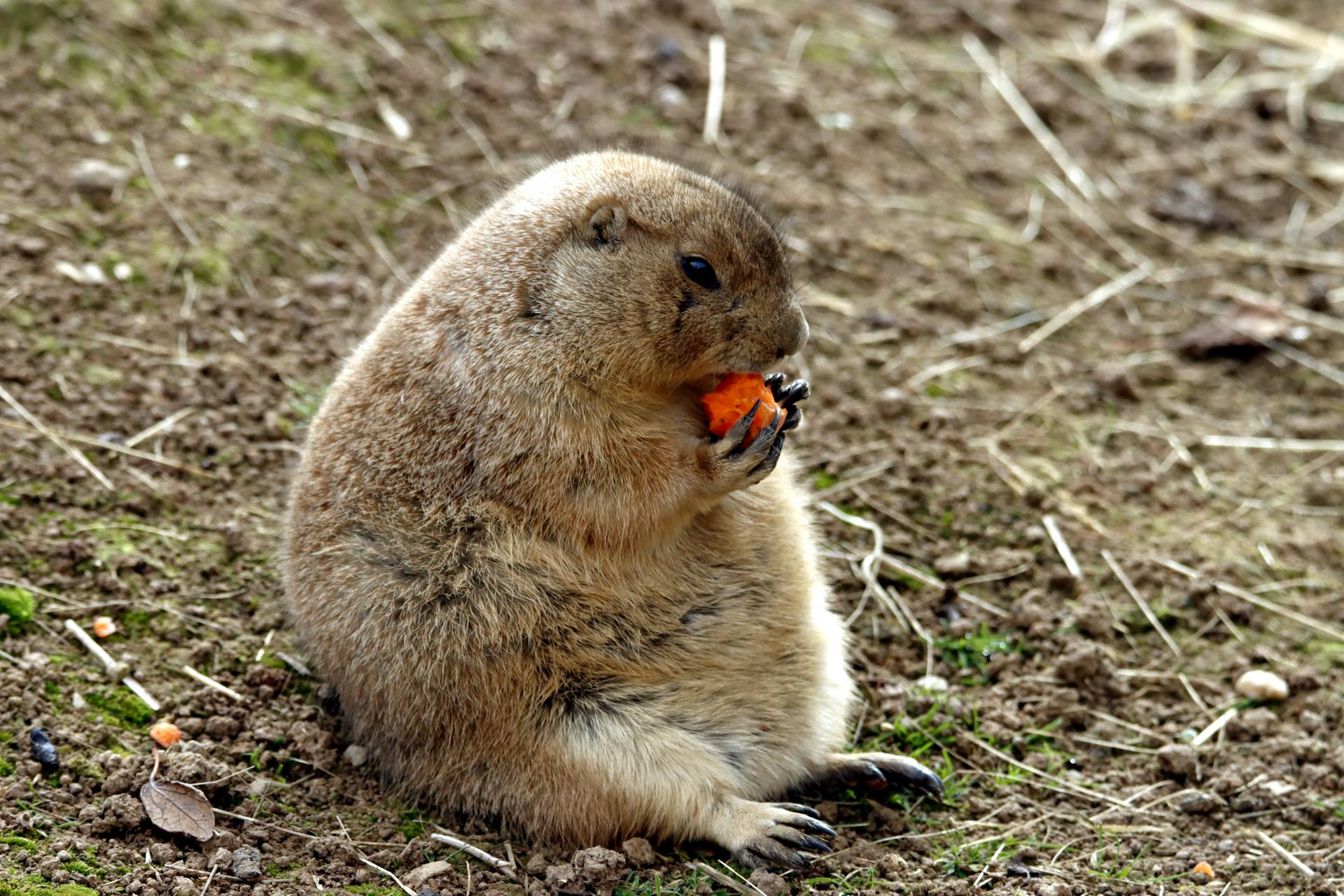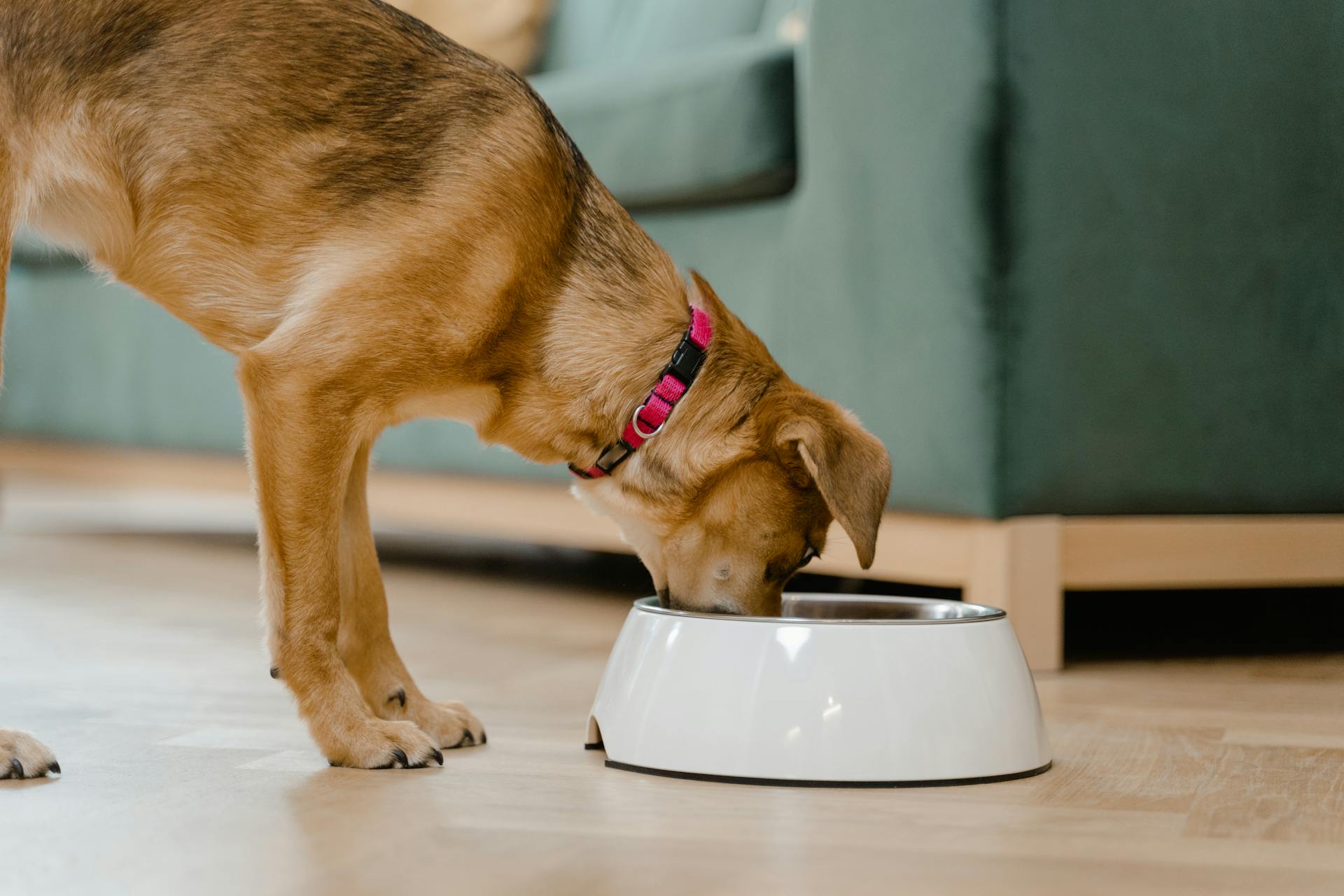
Dogs can choke on food, especially if it's not cut up into small enough pieces.
Choking on food is a serious issue and can be fatal if not treated promptly.
Dogs can choke on a wide range of foods, including bones, sticks, and even small toys.
In fact, a study found that dogs are most likely to choke on food when they're eating quickly or aggressively.
To prevent choking, it's essential to supervise your dog during mealtime and ensure they're eating slowly and calmly.
On a similar theme: Merrick Dog Food for Small Dogs
What Causes Choking?
Choking in dogs is often caused by eating something that's too big for their throat, like a bone or a piece of food that's larger than their esophagus.
Dogs can choke on food that's stuck in their throat, such as table scraps or even their own food if it's too big.
The shape and size of a dog's esophagus can make it hard for food to pass through, increasing the risk of choking.
Related reading: What Is the Best Large Breed Dog Food
A dog's tongue and lips can also get in the way of food passing through, making it harder for them to swallow.
Dogs may try to swallow large pieces of food quickly, which can cause them to choke.
Food that's too dry or hard can be difficult for dogs to swallow, increasing the risk of choking.
Recognizing Distress
A dog in distress from choking will likely look panicked or very distressed, and may even take on a bluish color of the skin or gums as the lack of oxygen becomes critical. This is a medical emergency that requires immediate care.
If your dog has a partial blockage, they might cough, whine, or look distressed, and their panic can increase their need for oxygen, leading to a vicious cycle.
Other signs of choking include pawing at their mouth, rubbing their face on furniture or the ground, salivating, or gagging. These behaviors can indicate that your dog is struggling to breathe.
Here are some key signs to look out for:
- Pawing at their mouth
- Rubbing their face on furniture or the ground
- Salivating
- Gagging
- Coughing
- Whining
- Looking distressed
If you notice any of these signs, it's essential to act quickly and get your dog to a nearby emergency vet as soon as possible.
Emergency Response
If your dog is choking on food, it's essential to remain calm and act quickly to prevent serious injury or even death. Don't panic, as this can cause your dog to thrash around and potentially bite or hurt you.
Restrain your dog using both hands, one on the upper and one on the lower mandible, to prevent them from moving around. Carefully pry open their jaws and fold their lips over their teeth to create a barrier between their teeth and your fingers.
To check for objects, peer inside your dog's mouth using a small flashlight, if available, and do a mouth sweep with your index finger to remove any small objects that can be easily removed, such as bones or sticks.
If you see a small object that's impossible to remove with a mouth sweep, like food or rawhide, use large tweezers or small tongs to take it apart or break it apart. Avoid pushing at it, as this can make it more lodged in the throat.
If you see a large object, like a ball or toy, press your thumbs underneath both sides of your dog's jaw near the base of the throat and press upwards to try and dislodge it.
Don't forget to check the roof of the mouth, as sticks or bones can often become lodged across that area.
If none of these options work and your dog is still in distress or unconscious, take your pet to the vet as soon as possible.
If you can't get to the vet in time and your dog appears to be gasping for last breaths, you may need to perform the Heimlich maneuver.
Readers also liked: Vet Approved Homemade Dog Food Recipes for Large Dogs
Prevention and Safety
To keep your dog safe, it's essential to monitor your surroundings for potential choking hazards. This includes keeping an eye on your dog when they're playing with items that could be a choking hazard, such as toys and bones.
Choose toys that are strong, sturdy, and able to withstand pressure without breaking for your dog. Avoid toys that can easily break into pieces when they're chewed on as they can get stuck in your dog's throat.
Suggestion: What to Feed Dogs without Dog Food
Feeding your dog food that's suitable for its size and age is also crucial. For example, don't give your small breed dog big bones to chew on. Instead, opt for food that's specifically formulated for your dog's needs, such as Petcube's gently cooked range.
By taking these simple steps, you can significantly reduce the risk of your dog choking on food.
Safe Security
To keep your dog safe, consider investing in a slow feeder if they tend to gobble their food down quickly. This simple step can help prevent choking hazards.
Monitoring your surroundings is also crucial, but it's not the only thing you can do. Take a course on pet first aid, either in person or online, to learn essential skills.
The Red Cross Pet First Aid app is a great resource to have on hand, and it's free to download. You can also take a course to learn more about pet first aid and how to respond in an emergency.
Curious to learn more? Check out: Freeze Pet Fresh Dog Food

If your dog is a heavy chewer, choose toys and bones that are designed for their needs. This will help prevent damage to your belongings and keep your dog safe.
Knowing what to do in an emergency is just as important as knowing where to go. Find out what emergency vet clinics are close to you and save their phone numbers in your contacts.
Future Prevention
To keep your dog safe, it's essential to prevent choking from happening in the first place. This means being mindful of the items your dog is playing with.
When your dog is chewing on toys or bones, keep a close eye on them to ensure they don't get stuck in their throat. Choose toys that are strong and sturdy, and avoid those that can easily break into pieces.
Feeding your dog the right food is also crucial. Don't give big bones to small breed dogs, as they can be a choking hazard. Opt for food that's suitable for your dog's size and age.
Children's toys are also a potential choking hazard, so keep them out of your dog's reach.
Consider reading: Can I Crack an Egg in My Dog's Food?
Hazards and Risks
Choking hazards are a real concern for dog owners. Common items that can be choking hazards include toys, treats, and food, especially hard foods like steak or kibble.
Dogs can choke on size-appropriate toys, so it's essential to check your pet's toys regularly for damage or loose pieces that could be swallowed. Dr. Fadl recommends removing chewed-up pieces of rawhide or large treats to prevent choking.
Reverse sneezing can be alarming, but it's usually harmless and caused by nasal congestion or irritation at the back of the throat. Dr. Hoggan notes that it sounds like a gasping for air, but it's just a normal behavior dogs use to clear their throat.
Bones, especially raw bones, can be a choking hazard. Dr. Hoggan warns that dogs can choke while eating bones, and raw bones can break into sharp pieces that may cause bleeding and infection.
A fresh viewpoint: Can an E Collar Choke My Dog
Cooked Bones
Cooked bones are a big no-no for your furry friends. They can easily break off into sharp pieces that can cause serious harm.
Recommended read: Food for Dogs without Teeth
Cooked chicken bones, turkey bones, and pork bones are all particularly hazardous. These types of bones can cause damage to your dog's mouth and GI tract.
If you're wondering whether it's safe to give your dog cooked bones, the answer is a clear no. It's best to avoid giving your dogs cooked bones of any kind.
For your interest: Dogs Eating Fish Bones
Raw Bones
Raw bones can be a good source of calcium and phosphorus for your dog. However, they are still potential choking hazards.
Raw bones are safer than cooked bones, but it's essential to consult with your vet before giving them to your dog.
Some of the best raw bones for your dog are lamb and beef, but it's crucial to monitor your dog while they're chewing on them.
Raw bones can break into sharp pieces that may cause bleeding and infection inside your dog, just like cooked bones.
Medical Conditions
Medical conditions can cause your dog's airway to become blocked, leading to choking and breathing difficulties.

Severe allergic reactions can make breathing very difficult due to swelling. This is a serious condition that requires immediate veterinary attention.
Respiratory infections can cause your dog's airway to become blocked with mucus, making it hard for them to breathe.
Collapsing trachea is a common issue in senior small dog breeds, where the windpipe becomes 'floppy', making it harder and harder to breathe.
Here are some medical conditions that can cause airway blockage in dogs:
- Severe allergic reactions
- Respiratory infections
- Collapsing trachea
Hazards
Choking hazards can be common and unexpected. Common items that can be choking hazards include toys, treats, and food.
Dogs can choke on items that aren't meant for them, like kids' toys. A German Shepherd being given a golf ball to play with is a classic example.
Even size-appropriate toys can pose a risk, especially if they're damaged or have loose pieces. Check your pet's toys regularly for any signs of damage.
Reverse sneezing can also be alarming, but it's usually harmless. It's a normal behavior dogs use to clear the back of their throat.
Some dogs make a hacking sound after drinking water, but if they seem calm and the sound stops, they're likely fine. Drinking too fast or moving their head while drinking can cause this sensation.
Susceptible
Some dogs are more prone to choking than others. Those who wolf down their food without chewing it—especially rescue dogs—might choke on their meals or treats.
Dogs with obsessive-compulsive and anxiety disorders can be a concern too. They might chew their toys and balls into pieces and swallow them.
Dogs who retrieve and gnaw on rubber balls over and over often inadvertently wedge them in their throats.
A choking dog is far more common than owners believe. Knowing basic signs and techniques will save canine lives.
Here are some signs to look out for:
- Difficulty swallowing
- Whining or gagging
- Blue-tinged lips or tongue
- Unresponsiveness
If you suspect your dog is choking, stay calm and act fast.
Frequently Asked Questions
Can a dog be choking but still breathing?
Yes, a dog can be choking but still breathing, especially if they're calm and able to inhale air. However, this doesn't mean the situation isn't life-threatening and requires immediate attention.
Sources
- https://www.marlborovets.com/blog/is-your-dog-choking-or-reverse-sneezing
- https://www.webmd.com/pets/dogs/risky-foods
- https://www.akc.org/expert-advice/health/dog-choking-dog-heimlich-instructions/
- https://www.thefarmersdog.com/digest/help-choking-dog/
- https://www.petcubes.com/blogs/can-dogs-eat-chicken-bones/what-to-do-if-choke
Featured Images: pexels.com


